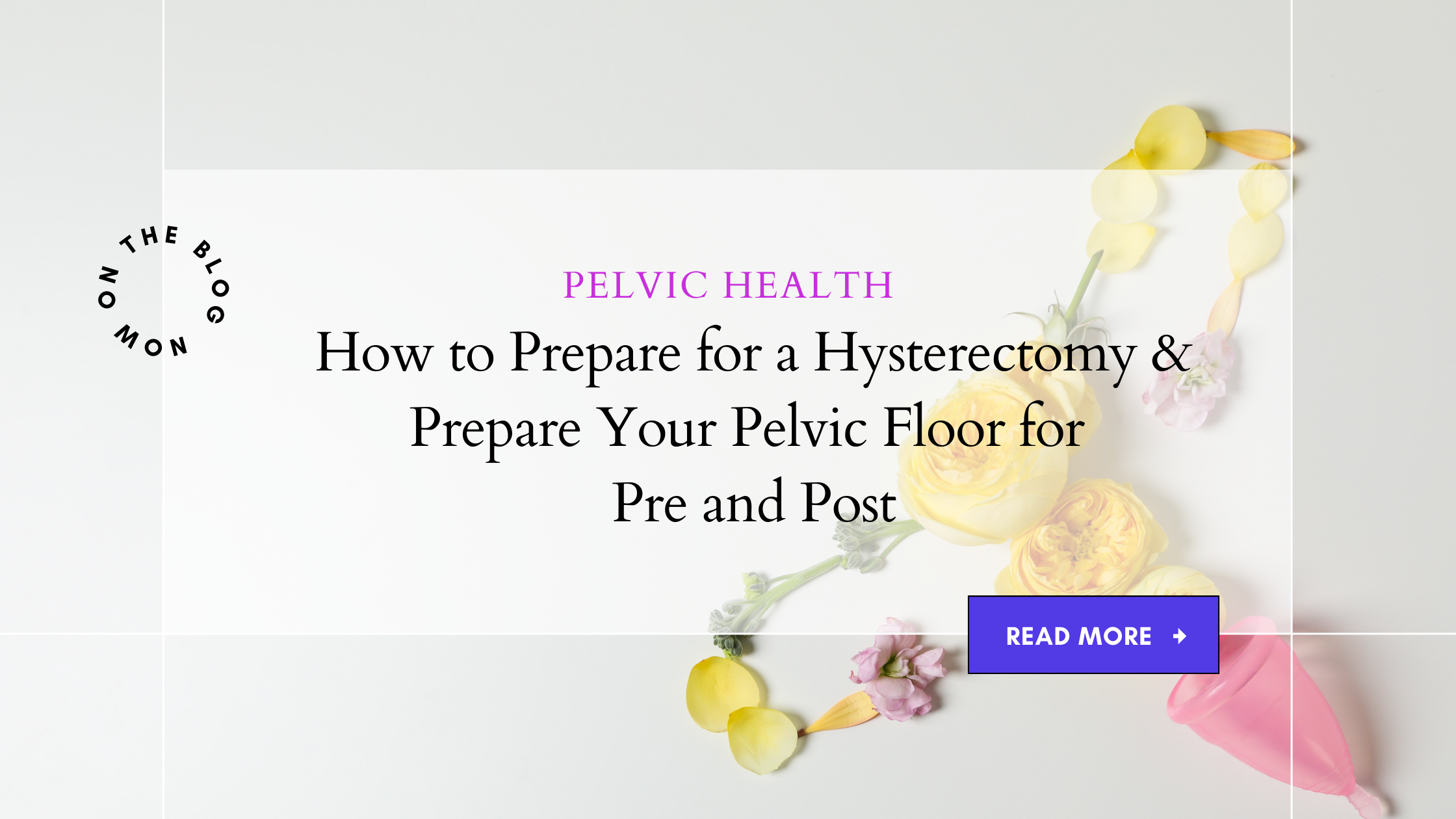So, your doctor just dropped the big H-word: hysterectomy.
Whether you saw it coming (years of fibroids, pain, or bleeding) or it blindsided you at a routine exam, hearing you need surgery to remove your uterus can feel like a lot. Overwhelming? Yes. Emotional? Definitely. But also… manageable — if you go in prepared.
And by “prepared,” we don’t just mean packing a cute robe for the hospital. We’re talking about arming yourself with the kind of smart, slightly sassy, fact-filled info your best friend (who also happens to be a pelvic health pro) would give you.
Here’s everything you need to know to prepare for a hysterectomy — your body, your mind, your pelvic floor, and your future self will thank you.
First, Let’s Demystify the H-Word
A hysterectomy is surgery to remove your uterus, and often your cervix. Depending on your condition, your surgeon might also remove your fallopian tubes, ovaries, nearby tissue, or even part of your vagina.
Afterward:
- You won’t be able to get pregnant.
- You won’t have menstrual periods.
- If your ovaries are removed, you’ll start menopause immediately (surgical menopause).
Why does anyone sign up for this? Because for some women, it’s the only way to treat conditions like:
- Heavy or prolonged bleeding that isn’t responding to other treatments
- Severe pelvic pain (hello, endometriosis or adenomyosis)
- Fibroids that are too big, too many, or too stubborn
- Gynecologic cancers (uterine, ovarian, cervical)
- Uterine prolapse (when your uterus drops into your vagina)
- Rare childbirth complications
The Menu of Hysterectomy Types (No, You Don’t Get Fries)
Not all hysterectomies are created equal. The type you have will impact your prep and recovery:
- Partial hysterectomy: Removes uterus, keeps cervix.
- Total hysterectomy: Removes uterus + cervix.
- Total hysterectomy with bilateral salpingo-oophorectomy: Removes uterus, cervix, fallopian tubes, ovaries. (Menopause, party of one.)
- Radical hysterectomy: Removes uterus, cervix, tubes, ovaries, part of vagina, and surrounding tissue/lymph nodes — usually for cancer treatment.
And how your surgeon gets in there matters, too:
- Abdominal: One large incision in your belly.
- Laparoscopic or robotic: Small incisions, faster recovery.
- Vaginal: No abdominal cuts; uterus removed through vagina.
Your Pre-Op Game Plan: The Smart Girl’s Guide
1. Ask Questions Like You’re Interviewing Your Surgeon for a Netflix Documentary
Get the details:
- Why this type of hysterectomy?
- How long will I be in the hospital?
- What’s the expected recovery time?
- Will my ovaries stay or go?
- Any pre-op tests I need?
- When can I drive, work out, or have sex again?
Pro tip: Write your questions down. The stress of “white coat brain fog” is real.
2. Build Your Recovery Crew
You’re going to need help. Not “oh, maybe” — you will. That means:
- Someone to drive you home.
- Someone to help with meals, kids, pets, and laundry.
- Permission to not be a hero. Your only job is healing.
3. Get Your Body Ready (Your Pelvic Floor Will Thank You Later)
Think of surgery like a marathon — you want to show up in your best shape possible. This means:
- Quit smoking (reduces healing time and lung complications).
- Eat nourishing foods (protein for tissue repair, fiber to fight constipation).
- Move your body (walking, gentle strength, low-impact cardio).
- Do pelvic floor exercises — yes, before surgery.
Research shows pelvic floor training before a hysterectomy can help prevent bladder leaks and prolapse afterward.
Source: Cochrane Review on Pelvic Floor Muscle Training
4. Learn the Exercises That Speed Up Recovery
Your surgeon wants you walking the day after surgery, but there are other moves that can make a big difference:
- Pelvic floor exercises (Kegels): Strengthen support muscles.
- Deep breathing: Reduces lung complications and helps relax pelvic floor tension.
- Circulation exercises: Ankle pumps and heel slides to prevent blood clots.
- Core activation: Gentle deep abdominal work to protect your incision.
Watch: Hysterectomy Recovery Exercises – Pelvic Floor Physiotherapy Video

5. Practice the “Log Roll”
You’ll use this to get in and out of bed without straining your incision. Practice now:
- Roll to your side.
- Use your arms to push yourself up while your legs drop over the side.
- Reverse to lie back down.
6. Make Peace With Bowel Prep and Bathroom Talk
Constipation after surgery is no joke — it can hurt your incision and pelvic floor. Learn the “brace and bulge” technique:
- Sit with feet apart, leaning forward.
- Rest elbows on thighs.
- Relax your belly and pelvic floor.
- Gently bear down without straining.
After Surgery: What to Expect (And How Not to Freak Out)
The Physical Stuff:
- Vaginal bleeding up to 6 weeks
- Incision soreness (or vaginal tenderness)
- Trouble peeing or pooping at first
- Fatigue that makes Netflix binges your new hobby
If your ovaries are removed, brace for menopause symptoms: hot flashes, vaginal dryness, mood swings.
The Emotional Stuff:
Some women feel relieved (goodbye pain and bleeding). Others feel grief or loss (goodbye fertility). Both are valid. If you feel anxious, sad, or not like yourself, talk to your doctor or a mental health professional.
Your Pelvic Floor After a Hysterectomy: The Plot Twist Nobody Warns You About
Here’s the thing: removing your uterus changes the pelvic real estate. Organs shift, support structures adapt, and sometimes this leads to:
- Bladder leaks
- Prolapse (other organs sagging down)
- Pain with sex
- Core weakness
This isn’t to scare you — it’s to say that pelvic floor physical therapy can be a game-changer. Ask your surgeon for a referral before you even leave the hospital.
When to Start Pelvic Floor Exercises After Surgery
Short answer: Not until your surgeon says it’s safe (usually 4–8 weeks).
When you do start:
- Begin with gentle breathwork and walking.
- Progress to Kegels, pelvic tilts, and eventually standing exercises.
- Keep it pain-free — no “no pain, no gain” here.
5 Post-Hysterectomy Pelvic Floor Moves
- Walking – Improves circulation and prevents stiffness.
- Diaphragmatic Breathing – Hand on ribs, inhale to expand, exhale to relax.
- Cat-Cow Stretch – Mobilizes spine and pelvis.
- Pelvic Tilts – Strengthens deep core and pelvic floor.
- Kegels – Done correctly (think sipping a smoothie up through your vagina, not clenching your butt).
The Bottom Line
A hysterectomy is major surgery — but it doesn’t have to wreck your confidence, your sex life, or your bladder control. Preparing your body, lining up support, and knowing what to expect can make recovery smoother, faster, and less stressful.
Your homework:
- Talk to your doctor about pelvic floor PT.
- Learn your pre- and post-op exercises.
- Set up your recovery squad.
And remember — you’re not “losing” something. You’re taking control of your health and making a decision that could give you a whole new quality of life.
Change the Way the World Sees Pelvic Health
For too long, women’s pelvic health has been treated like an afterthought. Peli Health is rewriting that story—with expert care, evidence-based tools, and real answers to the questions too many women have been told not to ask.
Join our Changemaker Plan for just $5/month (limited time) and get:
- A free 1:1 coaching call to get your questions answered
- Access to our MD-reviewed resource library
- Clinician-led workshops and programs that go far beyond “just do Kegels”
Your health. Your voice. Your movement.
Join the Changemaker Plan today.


